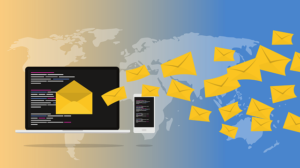11 Things You Must Know to Succeed With Inside Sales
I take dozens of consultation calls for cold email critiques and inside sales consulting every week.
Although the challenges and needs of my prospective clients vary depending on the size of the organization and the stage their company is at, many of the questions I hear often repeat themselves.
I recently held a webinar about cold emails that had more than 325 questions during the Q&A session, many of which could not all be answered live. I picked 11 of the most relevant questions to respond to, based on how frequently they were asked, and how important they are to running successful outbound email campaigns.
Here are the 11 questions with my answers:
Table of Contents
1) What’s a good cadence for sending cold emails?
I recommend sending 8 emails approximately 4 days apart, but anything between 3-7 days apart is okay. I usually avoid sending email campaigns on Mondays or any Fridays right before holiday weekends, but it depends on your audience (test everything and see what works for you!). If your inside sales team is also cold calling or sending messages with Linkedin InMail, Tweets, or other forms of communication, you might want to vary that a bit, but generally 4 days apart is an effective cadence.
2) Why should I send every prospect 8 emails and not just a few?
After sending millions of cold emails in the last decade, I can say with confidence (and data) that about 1/3 of your total responses will come from emails 5-8. So if you’re only sending 4 emails (or less) you’re losing out on at least 1/3 of your potential leads. Sending 8 emails allows you to be persistent while also testing a variety of value propositions mixed with different emotional appeals to see what resonates best with your prospects.
3) How can I send a prospect 8 emails without it sounding too spammy?
Every message you send should add unique value to your prospects. Messages start feeling obnoxious and spammy really fast when you start repeating the same redundant message over and over. Sending one email followed by 7 more emails that all say “Hey, I’m following up” isn’t doing you or your prospects any favors.
Each of the cold emails I write for myself and clients focuses on a unique idea or benefit. Before you start writing a single email, you should brainstorm and make a list of your product/services’ benefits, as well as your prospects’ priorities and pain points. This helps you plan your email campaign and avoid redundancy.

4) Why is it important to use an email tool when doing “cold emails” that utilizes mail merge instead of sending through something like Mailchimp, Marketo or Aweber?
Your cold email campaigns won’t be successful if they don’t look like they’re a one-on-one conversation. Mass emails immediately signal to your prospects that you didn’t take the time to send them a thoughtful message, which doesn’t incentivize them to make an effort to respond and schedule a call with you.
Tools like Mailchimp, Marketo, Aweber, and others are meant for used for sending mass marketing emails to people who already opted into your list, and therefore those individuals will be more familiar with you and interested in your business. If they sign up for your newsletter or webinar, they expect you will send them emails with valuable information, and so it doesn’t matter as much that these emails look mass.
The recipients of your cold email don’t know you and don’t care about your business, so they won’t take the time to respond to an email that looks like it was sent to 100,000 people. Sending mass emails with tools like Mailchimp make your email headers look mass (“sent from mailchimp.com”), whereas sending mass emails through a mail merge still resembles a personal email request. Mail merges will always inbox better (assuming you have your mail server configured correctly and that your domain hasn’t been blacklisted for spamming) and get more opens/responses than mass marketing emails.
5) What’s the best way to start a cold email?
You only have a few seconds to grab someone’s attention, so your first sentence needs to hook your prospects in immediately. The best cold emails usually start with compelling sentences that capture the prospect’s emotions, or intriguing questions that start thoughtful conversations.
EXAMPLE 1: “I have an idea that could potentially 3x {!Company}’s qualified leads that worked well for Box.”
EXAMPLE 2: “How are you generating qualified leads for {!Company}? Is your current response rate for cold email campaigns above or below 5%?”
6) Should I include URLs to click on in my cold email?
Be careful about including URLs in your cold emails, especially early on in the sequence. While links to great guidebooks and videos might help educate your prospects on your business, they often deter them from responding to your email because they feel like they already have everything they need from that collateral.
You also need to be careful about heavily relying on links to deliver the “meaty information” to your audience. Your prospects will never click your links if you don’t have persuasive calls to action to entice them to click on those links. If you leave all the meat of your pitch inside a piece of collateral, but neglect include something alluring in the email copy, that collateral will never be seen.
7) Should my cold emails have HTML or only be plain text?
Plain text! There should be absolutely no HTML or design in your cold emails. Cold emails are supposed to feel like individual one-on-one requests sent from a human, which means NO HTML/design! Just simple plain text like you would send to one of your friends or colleagues in a normal email.
Don’t do it!!!
8) How can I prevent or reduce the risk of being “blacklisted” as a spammer?
Make sure you are sending cold emails to a very targeted list of qualified potential buyers. You should only be reaching out to people that you genuinely think you can add value to. The “throwing spaghetti on the wall and hoping it sticks” approach of spamming 10,000+ unqualified leads is almost a sure way to get your domain blacklisted. Building a great list doesn’t happen magically. It takes time and money, but if you aren’t willing to do this you shouldn’t be sending cold emails. Also, make sure your cold emails actually add value to your prospects and aren’t just obnoxious/self-serving.
9) What’s the difference between B2B and B2C emails?
 B2B emails usually go out to a much smaller and more targeted audience. With B2C emails, you generally don’t have much information about the individual, unless you have spent a lot of time and money on generating a list. With the exception of Nigerian scammers, B2C emails rarely look or feel like personal one-on-one requests.
B2B emails usually go out to a much smaller and more targeted audience. With B2C emails, you generally don’t have much information about the individual, unless you have spent a lot of time and money on generating a list. With the exception of Nigerian scammers, B2C emails rarely look or feel like personal one-on-one requests.
While B2B emails are rarely thought of as fun or sexy, you need to remember that you’re still emailing living and breathing human beings, and so your copy should be enticing. When sending B2B emails, you have the advantage of being able to collect and leverage extensive data on your prospects (first name, company name, location, industry, etc) so make sure to leverage these fields in your cold emails. Generally the more you personalize your emails to feel like highly relevant one-on-one requests, the more responses you will get.
10) Why shouldn’t I open a cold email with “Dear Sir or Madam”?
Using excessively formal language like “Dear Sir” doesn’t sound natural or human. When you see that type of language you generally assume that you’ve just received an email from a mass marketer or someone who’s first language probably isn’t English.
Elementary school taught us that you start a letter with “Dear” and other formal rules, but this isn’t how people communicate in email in 2015. Unless you’re emailing the queen of England, keep your emails more informal and conversational. As a general rule, try to use first and second person (“you” and “I”) instead of third person (“they”). It sounds more natural and will warm up your prospects better.
11) How can I make my Calls to Action stronger and get more responses?
Your Calls to Action should always have an incentive for your prospects to respond. You need to entice them with value if you want to get a response. That benefit shouldn’t require buying your product either, but something they will immediately receive because they have a call with you. Your prospects’ time is valuable, so you need to convince them that you won’t waste it. (And asking your prospects for a “demo” is not exciting, unless you are selling the Oculus Rift!)
A great call to action could be: “When do you have 20 minutes so I can give you a few strategies for doubling your qualified leads?”
About the author: Heather Morgan

Heather R Morgan is the CEO of Salesfolk, a copywriting consultancy that helps B2B sales organizations write cold emails that start warm conversations with C-level executives.



